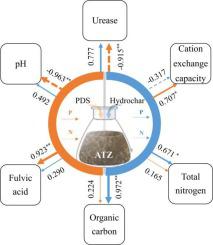Journal of Hazardous Materials ( IF 12.2 ) Pub Date : 2022-04-20 , DOI: 10.1016/j.jhazmat.2022.128944 Gang Xue 1 , Liangliang Zhang 2 , Xinyun Fan 3 , Kaijie Luo 4 , Shaopeng Guo 4 , Hong Chen 2 , Xiang Li 2 , Qiwei Jian 5

|
Peroxydisulfate (PDS) is widely used in field-scale remediation of organically polluted soil, yet PDS is detrimental to the soil microbiome. In this work, sludge-derived hydrochar was used to alleviate the oxidative damage of PDS to the soil ecosystem and simultaneously improve atrazine (ATZ) degradation. Response surfaces showed that ATZ degradation was enhanced with an increased dosage of PDS (regression slope of 24.09) and hydrochar (regression slope of 4.19). In contrast, bacterial abundance was negatively related to PDS dosage but positively to hydrochar dosage. At the optimum dosage of PDS (2.21% dry weight of soil) and hydrochar (5% dry weight of soil), ATZ degradation reached 95.31%, and bacterial abundance recovered to 7.72 log gene copy number g−1 soil (versus 8.44 in raw soil). Hydrochar alleviated the negative impacts of PDS on soil fertility such as urease activity. High PDS dosages (3% dry weight of soil) facilitated the proliferation of Halomonas, while moderate dosages (1.5% dry weight of soil) stimulated Alicyclobacillus. Hydrochar facilitated the growth of functional genera like Comamonas, Cloacibacterium, and Terrabacter. ATZ degradation pathway was positively correlated with Bacillus and nitrogen metabolism pathway. Hydrochar mediated intracellular reactive oxidative species scavenger reactions in catalase activity, allowing microbial survival under harsh oxidative conditions due to PDS addition.
中文翻译:

阿特拉津污染土壤土壤肥力和微生物组对水炭和过硫酸盐修复的响应
过二硫酸盐 (PDS) 广泛用于有机污染土壤的田间修复,但 PDS 对土壤微生物组有害。在这项工作中,污泥衍生的水炭被用来减轻 PDS 对土壤生态系统的氧化损伤,同时改善阿特拉津 (ATZ) 的降解。响应面显示,随着 PDS(回归斜率为 24.09)和水炭(回归斜率为 4.19)剂量的增加,ATZ 降解增强。相比之下,细菌丰度与 PDS 剂量呈负相关,但与水炭剂量呈正相关。在PDS(2.21%土壤干重)和hydrochar(5%土壤干重)的最佳用量下,ATZ降解达到95.31%,细菌丰度恢复到7.72 log基因拷贝数g -1土壤(相对于原始土壤中的 8.44)。Hydrochar 减轻了 PDS 对土壤肥力(如脲酶活性)的负面影响。高剂量 PDS(土壤干重的 3%)促进盐单胞菌的增殖,而中等剂量(土壤干重的 1.5%)刺激脂环酸杆菌。Hydrochar 促进了功能性属的生长,如Comamonas、Cloacibacterium和Terrabacter。ATZ降解途径与芽孢杆菌和氮代谢途径呈正相关。Hydrochar 介导过氧化氢酶活性中的细胞内反应性氧化物种清除剂反应,由于添加 PDS,允许微生物在苛刻的氧化条件下存活。













































 京公网安备 11010802027423号
京公网安备 11010802027423号